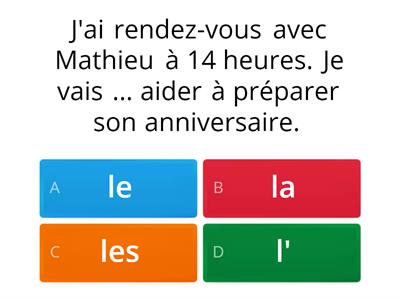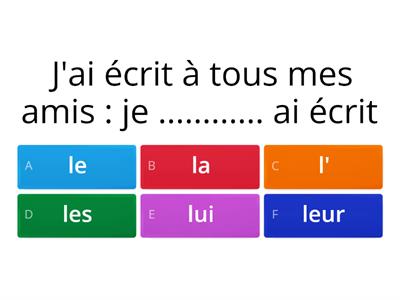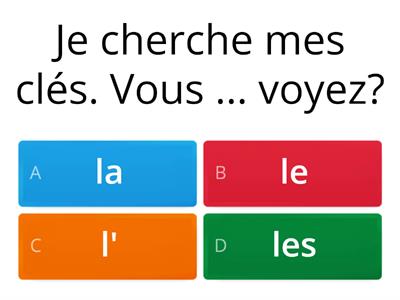Le, la, lui, leur,.. : how to choose the correct pronoun in French ?
Mastering the French pronouns is not an easy task. But it’s one of the best things you can do to improve your French conversational skills.
Le, la, lui, leur,… how can you choose the correct pronoun in French ? The world of French pronouns is vast. And there are dozens of different pronouns, suitable for different situations.
Therefore, learning how to use the French object pronouns will save you a lot of time. Furthermore, it will also make you sound more like a native. So, if you’re ready to move your French fluency to the next level, stay tuned.

1. What is a Direct Object Pronoun (pronom COD) ?
Firstly, the Direct Object Pronoun (pronom COD) replace nouns when there is no preposition after a verb. The completed verb is said to be direct transitive. We generally find a pronoun COD with verbs such as aimer (to like or love), voir (to see), connaître (to know) or vouloir (to want).
Tip : To identify a pronoun COD, you can ask the questions Whom ? (qui) or What (quoi) ?
ex: J’aime le chocolat > J’aime quoi ? = le chocolat
Je l’aime > J’aime qui ou quoi ? = l’ is Direct Object Pronoun
| SINGULIER | PLURIEL | |
| 1ère personne | ME / M’ = ME | NOUS = US |
|
Elle m’entend = She hears me Il me voit = He sees me |
Elle nous entend = She hears us Il nous voit = He sees us |
|
| 2ème personne | TE / T’ = YOU | VOUS = YOU |
|
Elle te contacte = She contacts you Je t’invite = I invite you |
Elle vous contacte = She contacts you Je vous invite = I invite you |
|
| 3ème personne | LE / LA / L’ = HIM / HER / IT | LES = THEM |
|
Vous la regardez = You watches her/it Il le lit = He reads it Je l’aime = I love him/her/it |
Vous les regardez = You watches them Il les lit = He reads it Je les aime = I love them |
As you can notice, pronoun COD are always before the verb introducing the complement replaced by the pronoun. This is a difference from english and can be a bit challenging in the beginning.
ex : J’entends les oiseaux > Je les entends = I hear the birds > I hear them
Attention : in the Passé Composé, the past participle using the auxiliary “avoir” agrees in gender and number if the pronom COD is placed before the verb.
ex: Elles ont acheté des tartes aux fraises > the past participle doesn’t change when the complement is after the verb.
Elles les ont achetées > the past participle needs to be conjugated
2. The definition of an Indirect Object Pronoun (pronom COI)
Basically, the Indirect Object pronoun, often abbreviated COI, brings essential information to the sentence. It is the person or the thing that is the recipient of the action. It answers the question after the verb :
- To whom? (à qui)
- To what? (à quoi)
- From whom? (de qui) or
- From what? (de quoi)
They replace nouns that follow verbs + à, like parler à, téléphoner à, demander à, offrir à, écrire à..
| SINGULIER | PLURIEL | |
| 1ère personne | ME / M’ = ME | NOUS = US |
|
Elle m’écrit = She writes to me Il me téléphone = He calls me |
Elle nous écrit = She writes to us Il nous téléphone = He calls us |
|
| 2ème personne | TE / T’ = YOU | VOUS = YOU |
|
Elle te demande ton avis = She asks for your opinion Je t’offre une fleur = I offer you a flower |
Elle vous demande votre avis = She asks for your opinion Je vous offre une fleur = I offer you a flower |
|
| 3ème personne | LUI = HIM / HER | LEUR = THEM |
| Vous lui écrivez = You write to him/her | Vous leur écrivez = You write to them |
Now, exactly for pronoun COD, the pronoun COI are placed before the verb:
ex: Elles ont téléphoné à leur mère
Elles leur ont téléphoné
3. Where to place pronouns COD and COI ?
Finally, another difficulty with French pronouns is that they are placed differently for various tenses. We have 4 possibilities that applies to direct object pronouns, indirect object pronouns and reflexive pronouns, and en and y.
3.1 Position of the French Object pronouns in the present tense
In the present tense, pronoun are always placed before the verb :
- Sujet + pronom + Verbe
- Sujet + NE + pronom + Verbe + PAS
ex : Tu regardes ce film ?
– Oui, je le regarde
– Non, je ne le regarde pas
3.2 Object pronoun in the Passé Composé and compound tenses
Next, a compound tense in French is composed of an auxiliary être (to be) or avoir (to have) and a Past Participle. We have 5 main composed tense : Passé Composé, Plus que Parfait, Conditionnel Passé, Futur Antérieur and Subjonctif Passé.
- Sujet + pronom + Auxiliaire + Participe Passé
- Sujet + NE + pronom + Auxiliaire + PAS + Participe Passé
ex : Tu as regardé ce film ?
– Oui, je l’ai regardé
– Non, je ne l’ai pas regardé
3.3. Future proche and semi-auxiliary verbs
Then, for the Futur proche and semi-auxiliary verbs, we place the pronoun before the infinitive. Semi-auxiliary verbs are structures using a first verb (such as pouvoir, vouloir, devoir,..) followed by the infinitive.
- Sujet + Verbe + pronom + Infinitif
- Sujet + NE + Verbe + PAS + pronom + Infinitif
ex : Tu va regarder ce film ?
– Oui, je vais le regarder
– Non, je ne vais pas le regarder
3.4 Imperative
Finally, in the imperative, we have an opposite position of the Object Pronoun in the affirmative and the negative form as follows :
- Verbe + ‘-‘ + pronom
- NE + pronom + Verbe + PAS
ex :
– Regarde-la
– Ne la regarde pas
4. Practical exercices with le, la lui, leur,.. in French
As a conclusion, let’s quickly practice object pronouns. You can find the answers at the bottom of this article. Bonne chance !
4. 1 Replace the complement by a COD or COI pronoun
- Paul écrit à sa mère
- Elle prépare la réunion
- J’ai demandé des informations à Pierre
- Tu pourras me prêter ta guitare ?
- Mia va envoyer cette lettre
- Je ne montre pas mon chat à Zoé
- Il a offert des fleurs à sa tante
- Nous racontons ce film aux enfants
- Présente-moi le nouveau docteur
- Je n’ai pas compris cette pièce de théâtre
4. 2 Find the correct answers



I hope you found this blog post helpful. Tackling the object pronouns is one of the hardest parts of every French learner’s journey. And I’d love to help you feel more confident !
For additional information, you can contact me anytime, anywhere in the world. Don’t forget that great new articles about learning French are also regularly published on French with Agnes blog.
Answers :
1 –
- Paul lui écrit
- Elle la prépare
- Je lui ai demandé des informations
- Tu pourras me la prêter ?
- Mia va l’envoyer
- Je ne lui montre pas mon chat
- Il lui a offert des fleurs
- Nous leur racontons ce film
- Présente-le moi
- Je ne l’ai pas comprise
2 – d /f / d

Comments are closed.